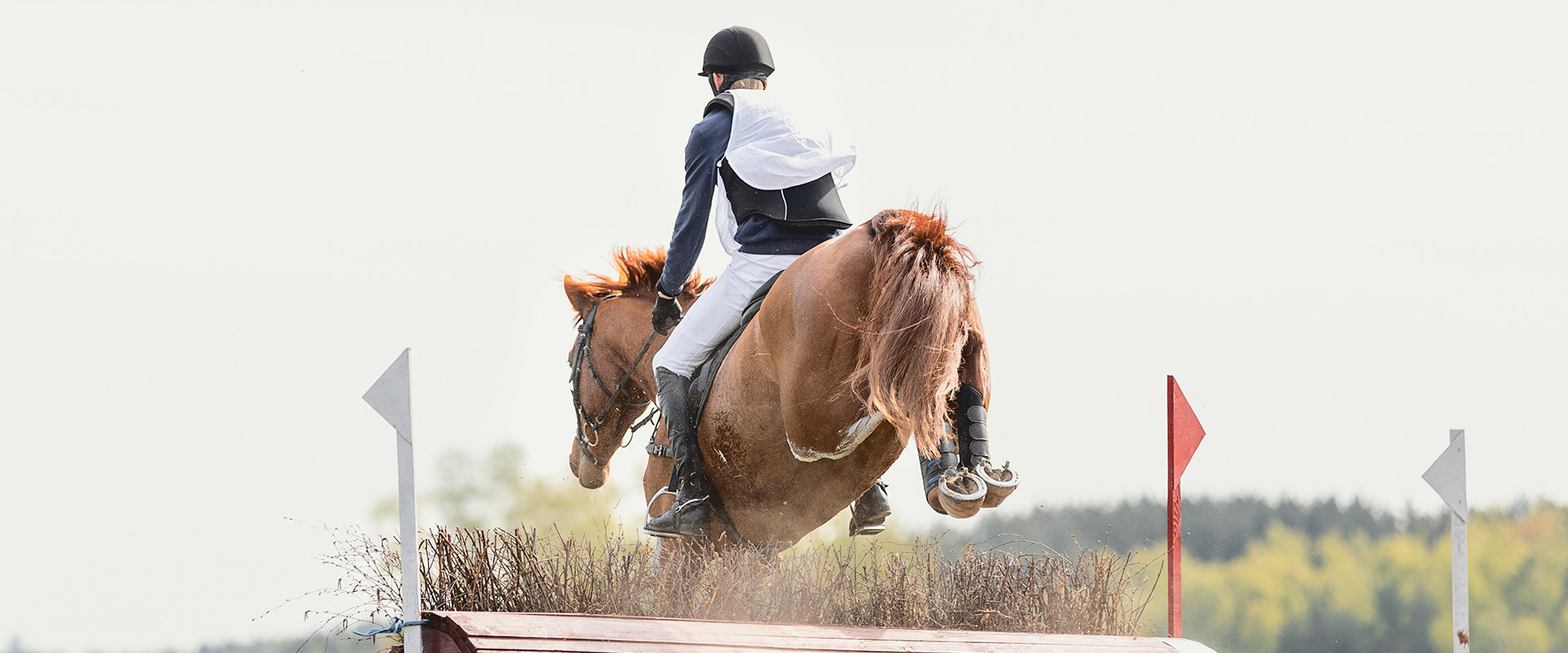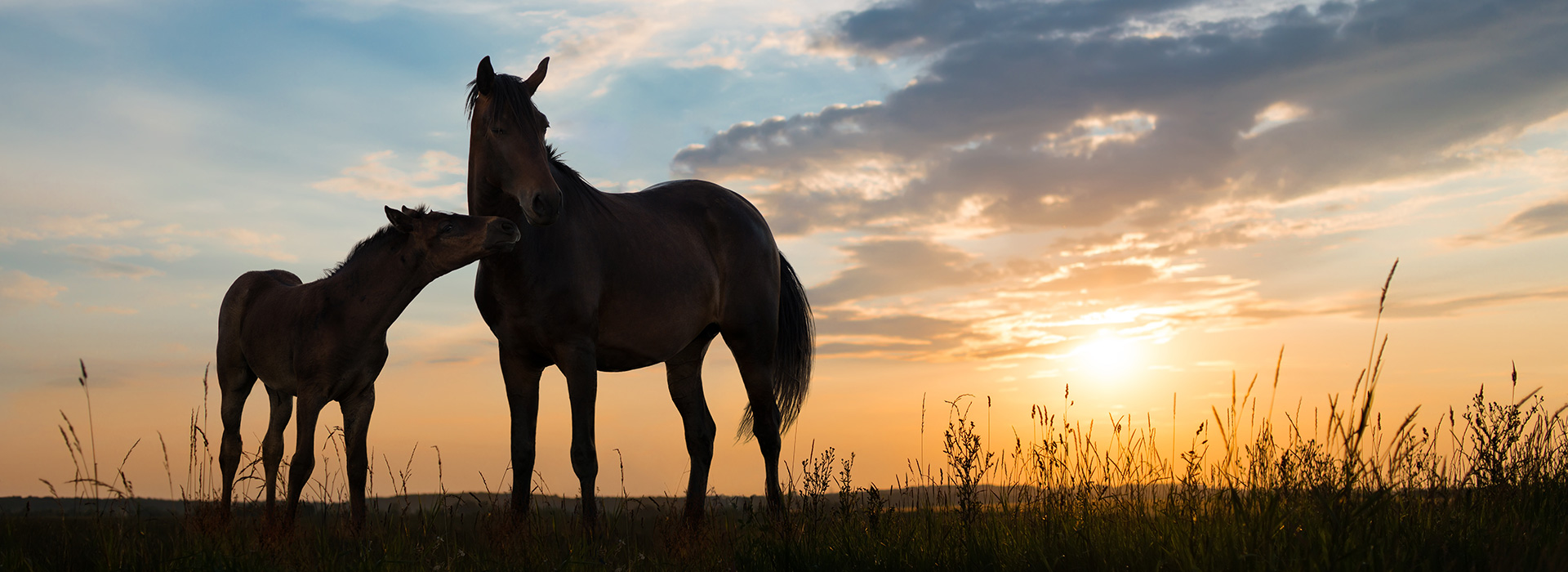When choosing the type of hay to purchase for the winter, it is always wise not only to choose the type your horse prefers, but also one that matches his nutritional needs.
All horses have different nutritional needs and thus the amount and type of hay they need may be very different.
The most economical feeding programs maximize forage intake and then add grain or other feeds to meet any unfulfilled requirements. High grain intakes have been implicated as a risk factor in equine colic, which is a good reason to feed as much hay as possible. Diets with low levels of hay have also been related to an increased incidence of stall vices such as cribbing and wood chewing.
The actual amount of hay that any horse will consume depends on its body weight and physiologic class (growing, lactating, or working) and the type of workload. All horses should have a minimum of 1.5% of body weight per day in roughage. As a rough guide a horse needing a restricted diet because of being either overweight or simply a good doer could be reduced to an absolute minimum of 1% per day. Should you experience problems with getting hay then you can reduce each individual horses amount to an absolute minimum of 1% per day, provided that additional roughage extras are provided (hay cube, beet products, additional chaffs), anything less puts your horse at risk for digestive upsets.
Horses in need of extra condition, those who are in harder work or mares that are pregnant or lactating could be increased to 2%+ per day. It is important, however, to always to consult a nutritionist to discuss you horses’ individual needs before making major changes to diet.Keeping these calculations in mind when you buy your hay, will allow you to ensure you have purchased enough.
But how to I know what I am Buying?
Simply looking at a bale of hay will not indicate nutritional value, however there are a few things to look out for which can indicate good value hay
Colour
Hay should be green in colour, with a pleasant aroma. A very sickly smell can indicate overheating and is to be avoided. Avoid hays that are more “straw” like in colour, as this can indicate excessive sun exposure. This will reduce the hay’s nutritional value in terms of vitamins and minerals. Brown hay should also be avoided as it can indicate rain damage.
Leaf to Stem Ratio
Another way to assess hay is to look at the leaves and stems. The leaves have a higher level of digestible nutrients than the stems and thus a larger leaf content is desirable. If the hay has a higher proportion of rough, thick stems and a very low leaf content, it generally points towards a less nutritious batch.
Harvesting
The biggest variable affecting nutrient content within a type of hay is the stage of maturity at harvest (cut). Very early cut hay often has a soft texture, is very leafy, and has a high nutrient density and palatability. These grasses are good for those horses with a higher nutrient need. Mid maturity hays are the most suitable for the average horse as they contain a good combination of leaf and stems while still being palatable.
Plants harvested in late maturity will have coarse, thick stems and less leaf. The older the plant at the time of cutting, the lower the nutrient value and the palatability, meaning fussy eaters may not take well to this cut. However, this type of hay can be a more desirable feed source for horses with lower nutrient requirements because the horses can eat more hay to satisfy their appetites without becoming overweight.
Types of Hay
Lucerne
Lucerne generally has a higher nutritional value than most hays and is thus more suitable for horses needing a higher level of nutrients per day such as horses in hard work, mares in foal or those who are lactating. It can also be useful in supplementing winter grass or poor summer pastures in grazing horses. Lucerne typically has a good ratio of stems to leaves, and provides as good level of energy, calcium, quality fibre, as well as other valuable nutrients. Mid cut Lucerne hay generally has a lower content of NSC and sugar making it suitable for those in need of a low NSC diet. Early cut Lucerne can contain a much higher value of NSC but this is in the form of pectin which is a safe form of carbohydrate for sensitive horses. First cut Lucerne grass mixes are much more risky, as the grass is often still in its growing stage when the Lucerne in its early bloom stage is cut for hay.
Lucerne contains little, fructan sugars and it is safe to feed 15-29% of the ration in weight as Lucerne hay to sensitive horses. Lucerne can be particularly high in energy & protein, which can be advantageous for those animals needing higher levels, such as stud and growing horses however it could cause excesses if the concentrate energy and protein level is not adjusted in the average horse. Many people think that the high protein level of Lucerne is to blame for horse being ‘’hot’’ however this is not the case. Adding a high energy hay such as Lucerne to a diet already covering your horses daily needs in terms of energy, will either mean the horse puts on weight or becomes hot. However if you reduced the level of concentrate feed, and replaced some of this energy value with that of Lucerne, the horse should not receive excess energy and thus not show signs of any unwanted behaviours.
It has been shown in many research studies that Lucerne, can assist in reducing the stomach ph of horses which may be desirable in gastric ulcer situations.
Note, however, that no horse should receive more than 50% of its daily roughage from Lucerne.
Oat Hay
Good quality oat hay which has been cut at pre mid bloom stage, is generally more palatable to horses than at other stages. However not all horses take to such hay and this can result in a high amount of wastage. A good quality cut contains an adequate level of nutrients for those in maintenance to light work.
Cereal grain hays, such as oaten, barley, rye or triticale hay are all high in NSCs and starch content during their growth phase. When cut at the optimum pre bloom stage (before flowering) for hay, they can contain in excess of 30% NSC and sugars. This makes cereal hays less ideal for sensitive horses. Once they seed however, the sugars are transferred to the seed head to form starch in the grain, leaving the stems with less sugar content.
Good quality oaten hay is likely to be the most dangerous for sensitive horses as it is often cut and cured before or at milk seed stage.
Teff and Eragrostis curvula
Teff and Eragrostis are perhaps two of the more widely used hay varieties in South Africa. They are often very palatable and provide a good amount of fibre without providing too high an energy value. This makes them suitable for the majority of horses. The major disadvantage of these hays is that the nutritional value can range hugely from good to extremely poor quality. The quality will ultimately depend upon stage of growth when cut, fertilization, and environmental factors. Always select these types of hay carefully, looking for optimum harvesting stage, colour and leaf to stem ratio. Studies have shown Teff hay can have a low NSC (non-‐structural carbohydrates) averaging around 10% or less. This makes it a suitable grass for those with issues such as laminitis, Cushings and Insulin resistance.
Relative Feed values (RFV) have also proved to be higher in Teff hay meaning that generally there is better intake, higher digestibility, and fewer additional needs to supplement the diet of the horse compared with other grasses.
Selecting Hay
Local availability often influences the popularity of a particular variety of hay in a geographical area. If you can’t guarantee a regular supply of particular hay in your area then rather choose one you know will be readily available.
Most important of all, however, is that the hay is clean and free of weeds and field contaminations (such as tin cans, twine etc). Hay that is mouldy or dusty should not be fed to horses, even when the amount of mould or dust appears to be minor. Any hay that contains dust or mould can inflame the respiratory tract and impair breathing ability.
Ideally before buying hay, a sample should be tested in order to get idea of the nutritional value, to assist your nutritionist in assessing the horse’s total diet.
Bale size
Does this really matter when selecting a grass? The answer is both ‘yes’ and ‘no’. Largely it depends on the amount of horses being fed. Small square bales are generally the most ideal in situations where only a few horses are being fed. The bales can be used quickly, reducing the chances of spoiling due to storage. These bales are often easier to store and don’t take up as much space. They are easy to handle and can be divided by the slice.
Large round bales, however, need more storage space and can often be difficult to use, as they muct be unwound, making filling hay nets harder. More wastage occurs as quite often the outer layers are not suitable for feeding and must be discarded. Large bales stored in a dry barn can be used successfully, however, if they are not stored correctly they can be susceptible to mould due to their compact nature. Large round bales should be used in situations where there are enough horses to use up the bale in few days. When a round bale is in a paddock with only one or two horses, it will be exposed to the elements for an extended period, reducing the nutritional value of the hay as well as making it susceptible to rotting or moulding.
Complied by Hannah Botha, References taken from http://www.uky.edu/Ag/AnimalSciences/pubs/id146.pdf




